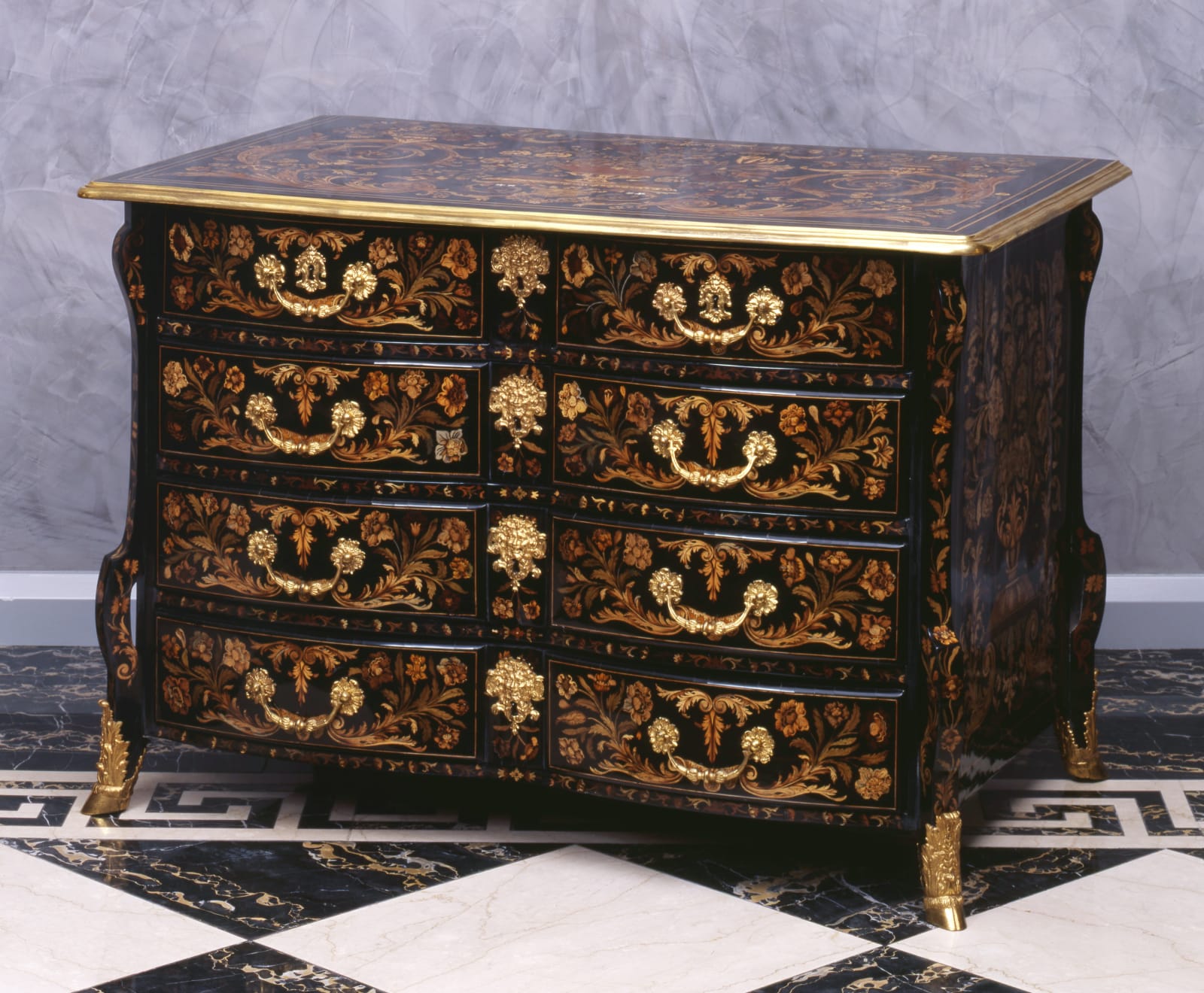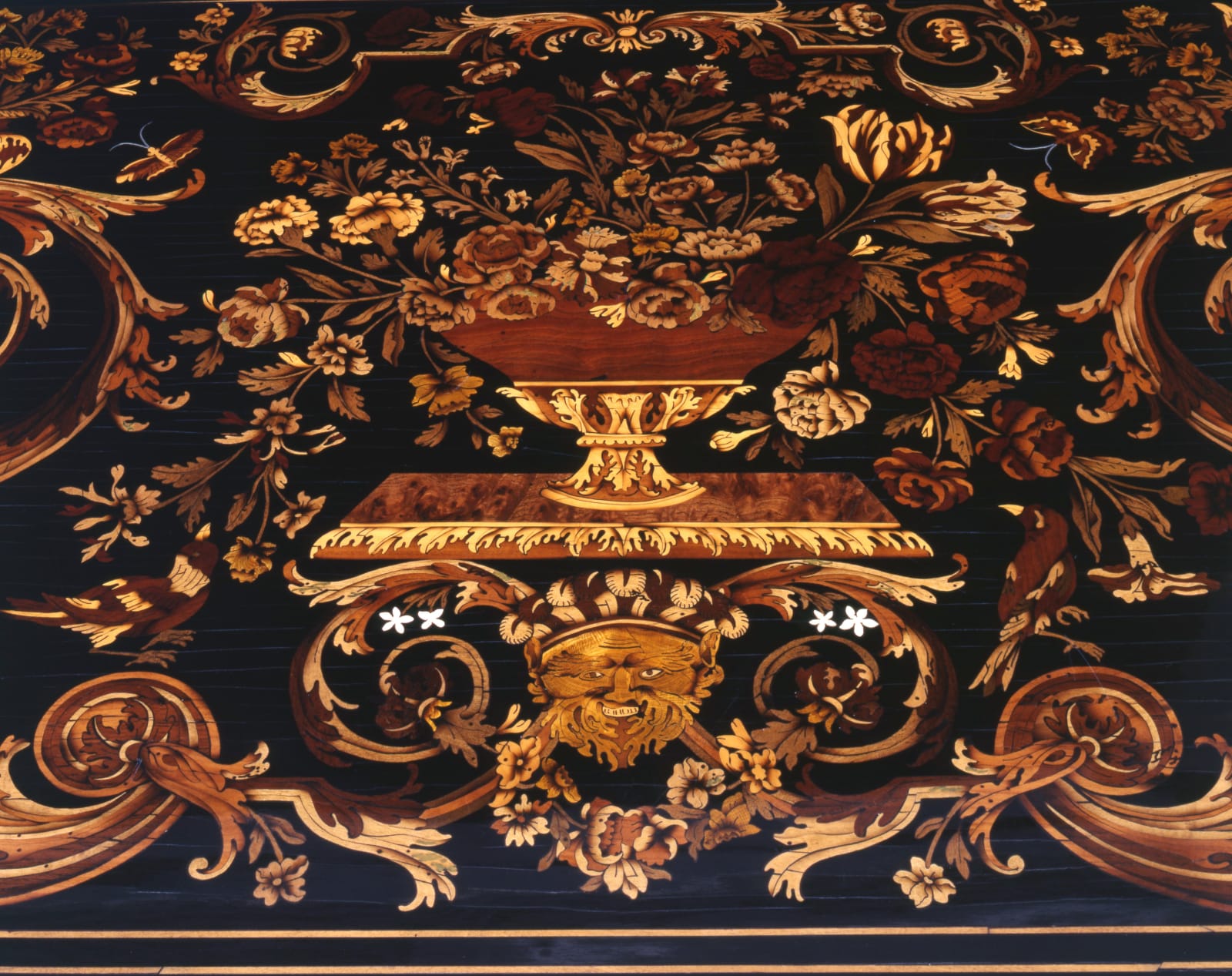Unknown
Literature
Pierre Ramond, "Chefs - d'Oeuvre des Marqueteurs", 1994; vol. I, pp. 144-145, illustrating an almost identical commode from the Gismondi Collection, Paris. Guillaume Janneau, "Le Mobilier Français - Le Meuble D'Ebénisterie", 1993, p. 20, pl. 20, illustrating a very similar commode.
A highly important and rare Louis XIV ebony, rosewood, maple, amaranth, sycamore, cherry, ivory, mother of pearl and brass marquetry commode, the rectangular top with brass banding exquisitely inlaid with a vase of flowers on a plinth above a grotesque mask head flanked by elaborate floral and foliate scrolls with further vase-filled floral bouquets, exotic birds and butterflies above two bowed drawers above three conformingly shaped long drawers, each inlaid with floral and foliate scrolls and with gilt bronze handles and escutcheons, centred by panels with grotesque mask escutcheons, the sides inlaid overall with a flower-filled vase on a plinth, the shaped angles with an undulating cut-out trim terminated by short legs with gilt bronze foliate and cloven-foot sabots
Paris, date circa 1710
Height 83 cm, length 124 cm, depth 72 cm.
This outstandingly beautiful commode, in perfect condition, is not only of great importance on account of its supreme craftsmanship but also due to its rarity and the fact that according to Pierre Ramond three other similar pieces by the same maker are housed in the Victoria and Albert Museum London, the Musée des Arts Décoratifs Paris and at Château de Versailles. Another commode from the Gismondi Collection Paris (see Ramond, ibid.) is almost identical though certain differences exist, notably the latter only has three tiers of drawers, the marquetry which uses slightly darker inlays also varies, it has an additional gilt mounted apron and the angles are simpler. A few other similar examples are known including one sold by Sotheby's New York 10th May 1995, lot 126.
As here, none of the comparable commodes bear a maker's stamp (which was not uncommon at this period) and nor has the ébéniste been conclusively identified. However it is clear that he was a great master of the period working in the circle of André Charles Boulle (1642-1732) and was most probably Auburtin Gaudron, who like Boulle specialised in the most sumptous and lavishly designed inlaid decoration. Unfortunately there is little documentary records relating to this fine maker to the extent that the comte de Salverte proposed that there may have been two men, a father and son working under the same name.
What is known of Auburtin Gaudron is that he was working during the latter part of the seventeenth century into the early years of the eighteenth and worked for the Garde-Meuble de la Couronne during the reign of King Louis XIV. Gaudron had a Paris workshop in rue Saint-Honoré where he worked for the Garde-Meuble Royal up until 1713 and also for the Menus-Plaisirs. Records reveal that in addition to Louis XIV, he supplied furniture to the Dauphin and Dauphine, as well as Madame de Maintenon, the duc d'Anjou, the duc de Chartres, the prince de Condé and other important clientele. Further evidence of Gaudron's excellent connections is provided by the fact that he was listed in the inventories of Henriette-Anne of England. Works by Gaudron supplied to such esteemed clientele include commodes also those known as bureaux en commode, armoires, cabinets and tables, usually lavishly inlaid with precious woods including ebony, as well as ivory, mother of pearl, brass and other metals.
Gaudron is recorded as having worked with the painter Jean-Michel Picart (1660-82) who specialised in flower pieces and whose work was also owned by Louis XIV. Born in Antwerp, Picart was working in Paris by 1635 where he achieved repute as a painter and also set himself up as a dealer. Picart's floral still-lifes provided the inspiration to many other painters. It is likely that they also inspired the floral designs for the present and other similar attributed Gaudron pieces since like Picart's work the inlays include lavish, undulating and brightly coloured floral bouquets. Gaudron is believed to have collaborated with other leading makers of his day. In particular he is known to have worked with the esteemed ébéniste Pierre Gole (circa 1620-84) who was appointed to Louis XIV and like Gaudron and his other contemporary and at one time co-worker André Charles Boulle specialised in sumptous, costly and lavishly inlaid furniture. Despite the similarity between the three the absence of any stamp on work by Gaudron or further documentary evidence has constantly challenged experts. And thus in the past, work by Auburtin Gaudron has often been attributed to the Boulle workshop though scholars now generally agree that his oeuvre should be reviewed and in particular attribute this type of commode to him.



